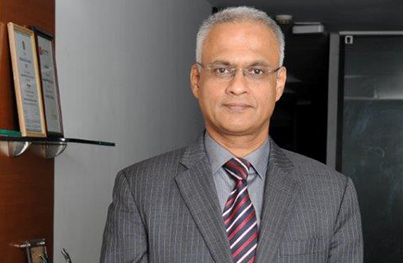With this offering we hope to provide our existing investors an additional lower risk reward option and also attract an entirely new set of customers to our AMC
BFSI Industry Interview

Sunil Subramaniam joined Sundaram Mutual in September 2005. During his tenure here he has handled various roles – Vice President (Retail Distribution), Executive Director (Sales and Marketing), Director (Sales and Global Operations), Deputy CEO, and CEO before being elevated to his current role as Managing Director. Sunil is also on the Board of Directors of Sundaram Asset Management Singapore Pte. Ltd.
In his tenure spanning over 15 years, Sunil has handled various responsibilities through which he has been instrumental in expanding Sundaram Mutual’s footprint both domestically and internationally. During the time he has been with Sundaram Mutual, the AUM of Sundaram Mutual has seen a manifold growth.
He has over three decades of work experience in the financial services sector across MNCs, Public and Private sector companies. The companies he has worked with include State Bank of India, American Express Bank and Bank of America.
Sunil has been recognized by The Economic Times as one of the Most Promising Business Leaders of Asia in 2018 and 2019. Under his leadership, Sundaram Mutual has won several accolades – The Economic Times Best Brands Award (2019), The Economic Times Best Brands Award in BSFI for two years in a row (2018, 2019), the YouTube Creator Studio Silver Award from Google for reaching over 100,000 subscribers and sharing original content on YouTube.
Sunil has a Master’s in Business Administration from The Open University Business School, London and is an MSc. graduate from IIT, Madras. He is also a Certified Associate of the Indian Institute of Bankers.
What is your outlook on the fall-out of COVID-19 on the Indian economy and the stock market? When can we expect to see recovery in the economy and corporate earnings? What will be the nature of recovery?
The economy should continue to experience a slowdown with negative GDP growth for atleast the next two quarters and may see a turnaround in the last quarter. Corporate earnings will reflect this, but we expect both GDP and Earnings to show a ‘V’ shape i.e. a sharp reduction in the negative Q-O-Q in this financial year and turn positive in FY 22.
Several fund managers who we interviewed since the outbreak of COVID-19, think that companies which are leaders in terms of market share in their respective industry sectors and typically they tend to be large cap companies will emerge stronger / recover stronger from this crisis. Please share your views?
We share this view as Size comes with Competitive Moats, ability to absorb short term blips, ability to pass on some of the pain to their smaller suppliers and distributors, the financial strength from Low Leverage and the flexibility to alter their business models to cope with the new realities. Besides those with strong cash flows and cash balances will be in a position to acquire ‘many small businesses which are feeling the extreme pain’ either in the competitive space or from a vertical integration perspective at very reasonable valuations - which should significantly enhance their competitive advantage in the medium term.
Sundaram MF is one of the oldest private sector AMCs in India with AUM of over Rs 31,000 crores (as on 31st Mar). You did not have a large cap fund though Sundaram Select Focus Fund is predominantly large cap oriented. You are launching a large cap NFO. Why are you launching a large cap fund now?
Select Focus has always been a large cap fund. We have however positioned it as a concentrated focussed fund and hence is a part of the High Risk-Reward segment of our offerings. It fitted in very well with the overall positioning of our AMC as ‘people who understand high risk and maximize reward through strong research capabilities and unearthing wealth creation opportunities at appropriate times’. We have built up a strong franchise of 1.8 million customers who have remained loyal to our vision and supported us through the ups and downs of the Indian Economy and Stock Markets. However, as a conscious strategy, over last few years, we have been implementing an action plan to deliver to our customers a more wholesome set of funds along the risk-reward spectrum. To this extent, we created an Equity Investments desk in Mumbai and brought in fresh talent, including Rahul Baijal to manage a portion of our large and multicap offerings. With SEBI reorganising fund categories in April 2018, we chose to keep Select Focus in the Focussed Large Cap category and began filling out the medium risk-reward category with New Fund Offerings such as Sundaram Equity Fund – A Multicap Fund and Sundaram BAF. Sundaram Bluechip follows through in this strategic path -being a more diversified Large Cap Fund lower in the risk-reward spectrum compared to Select Focus.
The timing of this launch at this period comes from a combination of
- The well-established credibility of Rahul Baijal in delivering long term wealth creation in the Large Cap space through both a Concentrated Select Focus (a 5 Star rated fund) as well as Diversified Equity Hybrid (a 4 Star rated fund)portfolios and
- The current parlous state of the economy requiring a high Safety element in an investor’s equity portfolio sitting parallelly with a solid long term economic potential proving a magnet for sustained long term oriented foreign investor interest in the Indian Stock Market - ideal positioning for large caps.
Thus, with this offering we hope to not only provide our existing investor base with an additional ‘Lower Risk-Reward’ option but also hope to attract an entirely new set of customers to our AMC
Over the last couple of years many investors and financial advisors have favoured large cap funds over midcaps, though small / midcap funds have rebounded in terms of performance in the past 3 – 4 months. How should investors think of market cap segment allocations in their mutual fund portfolios?
These thought processes and recommendations are synchronized with our own view of the economy being in the throes of a vicious cycle but with a medium term expectation of a V shaped bounce back – Our recommended equity capcurve based portfolio allocations at this point in time are as follows:
- Aggressive Allocation: Large 50%;Mid 30%;Small 20%
- Moderate Allocation: Large 70%; Mid 20%; Small 10%
- Conservative Allocation: Large 80%; Mid 20%; Small 0%
For the benefit of the average retail investors, please describe the salient features of your upcoming large cap fund NFO? What will be investment strategy of this fund?
The fund’s aim is to deliver Long Term Capital Appreciation with Lower Volatility through:
- A Diversified 45-50 stock portfolio
- Quality oriented ‘Bluechip’ stock selection
- Blend of Growth & Value
A common narrative in online media about large caps is that actively managed large cap funds have struggled to beat Nifty in recent years. Do you and your team feel that actively managed large cap funds can create alphas over sufficiently long investment horizons?
Yes – we do believe that in the medium to long term Quality Stock Selection based on company fundamentals has the capability to deliver Alpha over the Indices. For e.g. in the Nifty 100 (Benchmark of the Bluechip fund), only 46 stocks (out of 100) have consistently remained as constituents of the index. Rs 100/- invested in the index in 2009 would have grown to Rs 240/- in the index but a portfolio of these 46 stocks would have grown to Rs 289/-. This a demonstration of the value a fund manager can add through picking long term compounders.
Who should invest in Sundaram Large Cap Fund NFO? How should investors approach their investment in Sundaram Large Cap Fund? What should be the recommended investment tenures? Please share your thoughts?
Any investor who wants to achieve returns in excess of inflation but has an apprehension about the volatility of the broader stock markets is better off choosing a Largecap-oriented portfolio. Sundaram Bluechip, with its additional emphasis on ‘investing in Bluechips’ as a quality filter is ideally suited for such an investor. Investment tenures for equities should always be atleast a 3 to 5-year time frame especially in the current challenging economic conditions.
Mutual fund investments are subject to market risks, read all scheme-related documents carefully.
Recent Interviews
-
In Conversation with Mr Akhil Chaturvedi Executive Director & Chief Business Officer with Motilal Oswal Mutual Fund
Mar 26, 2025
-
In conversation with Mr Rohit Seksaria Fund Manager Equity with Sundaram Mutual Fund
Mar 7, 2025
-
Partner Connect by Advisorkhoj with Mr P Someswara Rao from Visakhapatnam
Mar 6, 2025
-
In conversation with Mr Deepak Mehta Head Strategic Alliances at UTI Asset Management Company
Mar 1, 2025
-
In conversation with Anunaya Kumar President and Head of Sales and Distribution 360 ONE Asset Management
Feb 21, 2025
Fund News
-
Kotak Mahindra Mutual Fund launches Kotak Energy Opportunities Fund
Apr 3, 2025 by Advisorkhoj Team
-
Groww Mutual Fund launches Groww Nifty 500 Momentum 50 ETF FOF
Apr 3, 2025 by Advisorkhoj Team
-
Groww Mutual Fund launches Groww Nifty 500 Momentum 50 ETF
Apr 3, 2025 by Advisorkhoj Team
-
ICICI Prudential Mutual Fund launches ICICI Prudential Nifty EV and New Age Automotive ETF FOF
Mar 28, 2025 by Advisorkhoj Team
-
UTI Mutual Fund launches UTI Income Plus Arbitrage Active Fund of Fund
Mar 21, 2025 by Advisorkhoj Team




